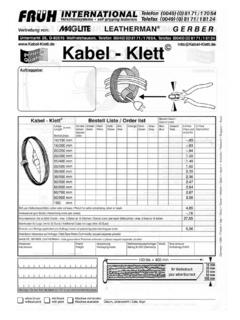Transcription of Objective colour assessment and quality control in the ...
1 Objective colour assessment and quality control in the chemical , pharmaceutical and cosmetic industries Application Report No. eLICO 690 2 3 Zusammenfassung In vielen Bereichen der chemischen Industrie werden die Farbbewertungen an Tensiden Glycolen, Harzen oder len h ufig noch durch visuelle Vergleiche der Produkte mit ent-sprechenden Farbstandards durchgef hrt, obwohl schon im Jahre 1931 durch die DIN 5033 die Basis f r eine objektive Farbmessung geschaffen wurde. Die EN 1557 definiert jetzt auch die Farb-messung an transparenten Fl ssigkeiten als Ersatz f r die visuellen Farbbewertungen mit der Jod-, Hazen- oder Gardner-Farbskala. Die Farbme ger te LICO 690 und LICO 620 der Firma Hach Lange vereinen die objektive Farbmessung nach diesen DIN-Methoden mit der gleich-zeitigen, ebenfalls objektiven Messung der herk mmlichen visuellen Farbzahlen.
2 Summary In many fields of the chemical industry, especially for surfactants, glycols, resins, food stuff, oil and cosmetic products, colour assessment by visual comparison of the product with the relevant colour standards is still going on, although as early as in the year of 1931, DIN-standard 5033 laid down the basis for Objective colour measurement. The EN 1557 rule that transparent liquids colours should be measured instead of being matched visually ( with Iodine DIN 6162, Hazen ISO 6271, Gardner ISO 4630 or Lovibond -yellow/red values). Colorimeters LICO 690 and LICO 620 produced by Hach Lange GmbH combine Objective colour measurement according to these DIN-methods with another Objective measurement of conventional visual colour values.
3 R sum Dans de nombreux domaines de l'industrie cosm tique, l' valuation des couleurs est toujours effectu e par la comparaison visuelle des produits avec des couleurs types alors que depuis 1931 les bases d'une mesure Objective des couleurs furent tablies par la DIN 5033. Actuellement la nouvelle EN 1557 d finit galement l' valuation de la couleur au moyen de liquides transparents comme substitut des valuations visuelles des couleurs (ex. iode DIN 6162, Hazen ISO 6271 ou Gardner ISO 4630). Les instruments de mesure des couleurs LICO 690 et LICO 620 de la soci t Hach Lange GmbH associent la possibilit d'une valuation Objective des couleurs selon ces m thodes DIN la mesure visuelle qui est galement Objective .
4 4 A From a visual assessment to Objective colour measurement A1 The term " colour " .. 5 A2 Visual colour Scales .. 6 The Iodine colour Number .. 6 The Hazen colour Number .. 6 The Gardner colour Number .. 7 The Lovibond - colour System .. 7 The Saybolt- and Mineral Oil colour Numbers .. 7 The European Pharmacopoeia - colour Number .. 8 The US Pharmacopoeia - colour determination .. 8 The Klett colour Number .. 9 The Hess-Ives colour Number .. 9 The Yellowness-Index .. 10 The ADMI colour Number .. 10 The ASBC and EBC brewery colour Number .. 11 B The Principles of Objective colour Measurement B1 The human eye .. 13 B2 The influence of light on colour perception .. 14 B3 Methods of colour measurement .. 15 Visual colour matching.
5 15 The tristimulus method .. 15 The spectral method .. 16 B4 Colorimetry and standard colour systems .. 17 The CIE 1931 colour Space (tristimulus system) .. 17 The CIE-L*a*b*-system .. 18 The Hunter-Lab-system .. 20 B5 New EN 1557 .. 20 C Instruments for colour measurement of liquids C1 The LICO 690 .. 22 C2 The LICO 620 .. 24 D Annex D1 Test Media Inspection .. 25 D2 Cuvettes and Accessories .. 25 D3 References .. 26 D4 LICO Instrument overview .. 27 5A From a visual assessment to Objective colour measurement Exacting quality standards and the companies interest in certification paved the way to colour measurement in the chemical , pharmaceutical and cosmetic industries daily lab routine.
6 Therefore, suitable measuring procedures must provide Objective and traceable production data for documentation which will prove in case of customer s complaints that given tolerances have been met. Ever constant product characteristics evidence good quality in the opinion of clients and users. Such constancy, however, cannot be maintained by purely subjective assessment in view of nowaday s high demands on quality . Many different colour systems have been developed for visual colour assessment since the beginning of this century, some of which can still be found among the evaluation criteria of test reports. While industry agreed to a uniform Objective method according to DIN 5033[1] and the CIE-Lab- colour system[2] , there is still a large variety of different colour scales like Iodine, Hazen or APHA, Gardner, FAC or Klett-numbers to describe the colours of liquids.
7 The drawback of these colour scales is the fact that often only some product colours can be clearly assigned to the selected scale. It is often necessary to assess a product once against the Iodine scale, then against Hazen or Gardner scales. A1 The term " colour " Every object has individual material qualities or characteristics, for instance volume, extension or density. colour assessment focusses on the optical characteristics of the material, its ability to modify incident light waves. If an object is exposed to light, it reflects a certain portion of the light, absorbs another portion and transmits the rest. According to DIN 5036, the relations of these portions to the entire amount of incident light are identified by reflectance (reflected portion), transmittance (transmitted portion) and absorptions (absorbed portion), with this equation valid for all media: Reflectance is the basic value for colour measurement at reflecting materials (surfaces).
8 Transmittance is the basic value for colour measurement at transparent materials (clear liquids, foils). The term " colour " has many different meanings. It is used for the paint which a painter applies to a canvas. It is also used for a characteristic of an object the eye perceives. In the sense of standardisation, " colour " is a sensual perception the human eye transmits to the brain. DIN 5033 sheet 1 defines: " colour is the sensation of a part of the visual field which the eye perceives as having no structure and by which this part can be distinguished alone from another structure less and adjoining region when viewed with just one motionless eye". ++ = 1 (1) 6 colour perception is, like any other spatial perception, three-dimensional.
9 This means that colours can be described by three clear measures of quantity like lightness, hue and saturation, unless verbal descriptions (pink, sky-blue etc.) or, if suitable standards are available, comparative statements like RAL 9001 or Iodine number 5 are considered satisfactory. A2 Visual colour Scales The still common visual colour systems to assess the colours of transparent liquids were elaborated at the end of the last century. At that time, these colour systems were defined as the first means to match product colours with standard solutions. The parent solutions were made from potassium-palatinate, iodine or ferric chloride and diluted to smaller colour gradations. The most common ones beside Iodine, Hazen and Gardner colour values are the Saybolt- colour number, the mineral oil colour according to ISO 2049 and ASTM D-1500, the Klett- colour number in the cosmetic industry, the FAC1-scale, the EBC-scale and the scale according to the European pharmacopoeia.
10 Moreover, there are many other colour systems like Shellac-, Woma2-, Dichromate- or Barratt- colour scales. The Iodine colour Number DIN 6162 defines the Iodine colour number as mg of iodine per 100ml potassium iodide solution. colour matching with the Iodine number serves to assess the colour depth of clear liquids like solvents, plasticizers, resins, oils and fatty acids with colours similar to that of the iodine-potassium-iodide solution at the same path length. For Iodine values around 1 or smaller, it is recommended to use the Hazen colour number according to DIN-ISO 6271. DIN 6162 rules that the iodine colour reference solutions be verified at least once a year by comparison with fresh solutions.







